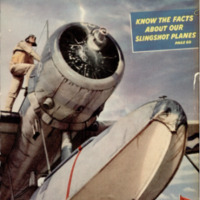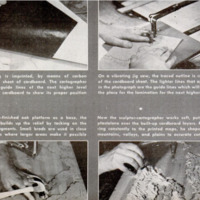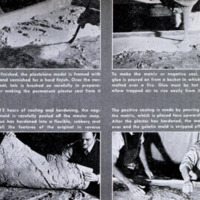Plastic relief maps
Item
-
Title (Dublin Core)
-
Plastic relief maps
-
Article Title and/or Image Caption (Dublin Core)
-
Title: Relief maps explain strategy of global war
-
Subtitle: Here's how these accurate plaster models are made
-
extracted text (Extract Text)
-
First stop in making a relief map is fo
photograph selected physical maps in sev-
eral sections, making enlarged prints to
the scale of the desired relief model.
Contour lines on these photographs, show-
ing various elevations of land, are then
traced, one level at a time. These trac-
ings will serve as guides fo establish
levels on the finished map. Here workers
are tracing contours in the Red Sea area
In newspapers and magazines
you have seen the sweep of
armies and the strategy of
global war made clear
through relief maps in which
oceans, mountains, and val-
leys stand out as if viewed by
an observer on the moon. Pic-
tures on these pages show
how skilled scul ptor-cartogra-
phers build these models that
give you a ringside seat as
history is made.
If the finished relief map is to be
used for photographic reproduction,
as at the right, seas and oceans are
painted light blue, the rest left
white. An artist-cartographer puts
in such details as international
borders, place names, and routes.
An advantage of relief maps is that
fhey con be photographed from any
angle. This shows the Mediterranean
war theater as viewed from the east
A DUAL TACHOMETER and synchroscope
has been designed by the Kollsman In-
strument Division of Square D Co.
Elmhurst, N. Y,, to aid in synchroniz-
ing the motors of a twin-engine plane.
As shown below, the dial has two
marked r.p.m. indicators. At the low-
er part of the dial is the synchroscope
whose disk rotates to the right or left
to indicate which engine is running
faster. The pilot matches the pointers
as closely as possible, and then makes
a final adjustment from the synchro-
scope. When the latter is stationary,
the motors are synchronized.
SAFETY HELMETS of transparent plastic are
being made by the Celanese Celluloid
Corp. to protect the hair of women fac-
tory workers from dirt and from being
caught by the grasping “fingers” of
whirling machinery. A snood protects
the hair at the back of the head.
MAGNETIZED PLANES have been revealed as
the means formerly used by the British to
explode magnetic mines in the Thames
estuary and Suez Canal. Wellington bomb-
ers equipped with a huge steel hoop encas-
ing a live magnetic coil were used for the
dangerous work, which required the planes
to fly only 60 feet above the water. Ford
V-8 auxiliary motors supplied current to
the coils. The entire practice was finally
abandoned when the degaussing gear was
developed for the protection of shipping.
SPECIAL INSIGNIA showing that the wearer has participated in
two or more actions for which his unit has been cited are be-
ing issued to individual members of the Army Air Corps. The
insigne, a blue ribbon framed in gold laurel leaves, is worn
on the left breast. An oak-leaf cluster in the center shows
that the unit has received two citations.
-
Language (Dublin Core)
-
eng
-
Date Issued (Dublin Core)
-
1943-05
-
pages (Bibliographic Ontology)
-
74-77
-
Rights (Dublin Core)
-
Public Domain (Google Digitized)
-
Archived by (Dublin Core)
-
Matteo Ridolfi
-
Marco Bortolami (editor)
 Popular Science Monthly, v. 142, n. 5, 1943
Popular Science Monthly, v. 142, n. 5, 1943




